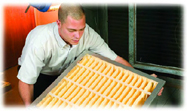
Figure 1.
THE FILTRATION EFFICIENCY EQUATION
The first step in determining the best type of HVAC filter needed is to identify the types and sizes of particular pollutants in the building. Figure 1 shows sizes of various particles that may cause IAQ problems - from submicron smokes and fumes to larger dust particles.Removal of all airborne contaminants is simply not practical in most facilities, so once problematic pollutants are identified, it’s time to look at filter efficiency. Filtration efficiency defines how well the filter cleans indoor air by removing airborne particles.
Low-efficiency filters (in the range of 25 percent efficiency on 3-10 micron particles) are typically used to keep lint and dust from clogging the heating and cooling coils of an HVAC system. Medium- and high-efficiency filters (up to 95 percent efficiency on 3-10 micron particles) are typically used to remove bacteria, pollen, soot, and other small particulates.
ASHRAE HVAC STANDARDS
The American Society of Heating, Refrigerating and Air-Conditioning Engineers (ASHRAE) has developed an HVAC filter test standard to quantify the efficiency of filters. The ASHRAE 52.2-1999 standard measures the fractional particle size efficiency (PSE) of an HVAC filter. This indicates the filter’s ability to remove airborne particles of differing sizes between 0.3 and 10 microns in diameter. A Minimum Efficiency Reporting Value (MERV) is assigned to the filter depending on the PSE in three different particle size ranges (0.3 to 1 micron, 1 to 3 microns, and 3 to 10 microns). The MERV is a numerical system based on minimum PSE. A rating of 5 is least efficient, while a rating of 16 is most efficient.In addition to the performance factors measured under 52.2, consider these additional variables when selecting a filter:
• Moisture resistance - how high humidity and moisture affect the filter.
• Temperature limitations - how the filter performs at application temperatures.
• Flammability - how the filter performs in flammability tests. Check to see if UL Class I or Class II rated filters are needed to conform to local building codes.
Tip:To make the right filter choice, do not simply focus on MERV, as the MERV scale is non-linear. To make the best choice, review the Fractional Particle Size vs. Particle Diameter curve that is included with the test report. The curve will tell you the efficiency of the filter for the specific particle size you’re interested in. Refer to Figure 1 to determine the size of the particles you are interested in capturing.
FILTER TECHNOLOGY
There are many types of HVAC filters on the market today. In most buildings, the best filter choice is a medium-efficiency pleated filter (MERV 7-8), which has a large filter media area. Keep in mind that large filter media areas tend to be more cost-effective than smaller ones. Large filter media areas mean lower pressure drop and greater contaminant-holding capacity. Lower pressure drop reduces fan energy requirements, and greater contaminant-holding capacity may mean fewer filter changes.
ADVANCED SYNTHETIC FILTER MEDIA
Pleated air filters used in HVAC systems are made with a wide range of filter media, including fiberglass, polyester, paper, and synthetic nonwoven materials. Recent advances in nonwoven technologies have allowed for improvement in both performance and value of synthetic filter media over the standard cotton/poly blends used for years in HVAC filters.Unlike traditional cotton/poly media, the synthetic filter media in more modern filters can be made of thermally bonded, continuous, hydrophobic (moisture-repelling), polyolefin fibers that resist shedding and do not absorb moisture. This is important in resisting bacterial growth, and it keeps shed fibers from getting into the HVAC coils or into the air space of the building. Moreover, synthetic filter media can be manufactured without the use of chemical binders, meaning that humidity will not affect the structure of the filter. Unlike cotton/poly filter media, which are made with a surface-loading structure, synthetic filter media can be made with a gradient density structure that provides a solid mechanical foundation to maintain high efficiency over the useful life of the filter.
Reprinted with permission from the Kimberly-Clark Filtration Products publicationFiltering Out Confusion – A Guide to Understanding HVAC Filter Selection.For more information on HVAC filter technology and IAQ issues, visit www.kcfiltration.com or e-mail filtration_media@kcc.com.
Publication date:04/09/2007

Report Abusive Comment